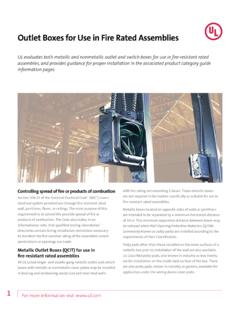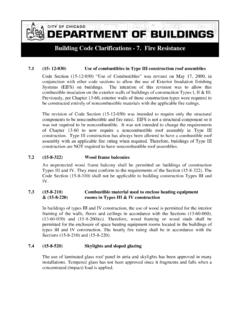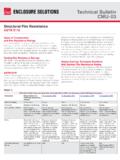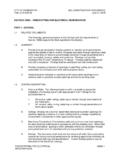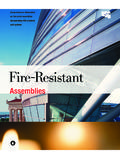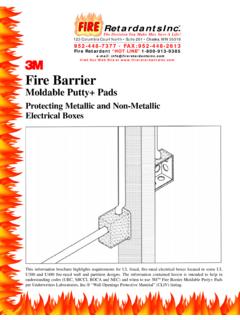Transcription of 2012 IBC Use of Fire and Smoke Separations- - vfpa.org
1 2012 IBC Use of fire and Smoke Separations Course Description This seminar addresses the provisions of the 2012 International Building Code . 2012 IBC Use of fire and (IBC ) regarding the use of fire and Smoke separations. Smoke Separations Based on the 2012 International Building Code, IBC . 2012 IBC Use of fire and Smoke Separations 2. Objectives Upon completion, participants will be better able to: 1. Identify the general types of fire and Smoke Course Overview separations Module I fire and Smoke Protection Concepts 2. Identify those specific components that make up fire Module 2 Types of fire and Smoke Separations and Smoke separations Module 3 Components of fire and Smoke Separations Module 4 fire and Smoke Separation Locations 3. Determine where separations are required 4. Determine where separations are permitted as alternatives to other requirements 2012 IBC Use of fire and Smoke Separations 3 2012 IBC Use of fire and Smoke Separations 4.
2 Copyright 2013 International Code Council #1085 PDF12 1. 2012 IBC Use of fire and Smoke Separations Concepts of fire and Smoke Protection IBC uses fire and Smoke assemblies and protectives for a variety of purposes Module 1. Structural integrity fire and Smoke Protection Limitation of fire spread Protection of exitways Concepts Radiant heat exposure Restriction of Smoke movement 2012 IBC Use of fire and Smoke Separations 5 2012 IBC Use of fire and Smoke Separations 6. Structural Integrity Structural fire Resistance Under fire conditions, larger buildings Structural fire -resistance is intended to and/or buildings contain high-hazard protect the structural integrity of building occupancies, selectively require specified elements during fire conditions. levels of fire -resistance for structural Such elements include: members Structural frame members. IBC Chapter 6 regulates structural integrity Bearing walls. through process of classification by Type Floor construction.
3 Of Construction Roof construction. 2012 IBC Use of fire and Smoke Separations 7 2012 IBC Use of fire and Smoke Separations 8. Copyright 2013 International Code Council #1085 PDF12 2. 2012 IBC Use of fire and Smoke Separations Limitation of fire Spread Protection of Exitways Multiple conditions throughout the IBC utilize As means of egress systems become more fire -resistive separations as a means to limit complex, fire -resistance-rated and/or Smoke - the spread of fire . resistant construction is often mandated. Complete fire or partial fire separations are The exit portion of the means of egress is either mandated, or provided as an typically where such protection must be alternative, to address a variety of issues. afforded. Vertical and/or horizontal separations fire protection of exitways allows for typically require opening protectives and extended travel in large area or multi-story other components to achieve full separation.
4 Buildings. 2012 IBC Use of fire and Smoke Separations 9 2012 IBC Use of fire and Smoke Separations 10. Restriction of Smoke Movement Radiant Heat Exposure Various conditions are addressed in the IBC. As a means to address the spread of fire where the primary consideration is Smoke - from building to building due to radiant heat resistance. transfer, fire -resistance-rated exterior walls Other conditions require a separation that are required based upon proximity to lot includes both Smoke -resistance and fire - lines and other buildings on the same site. resistance Concept of fire separation distance applied Smoke -resistant construction is often to regulate exterior wall fire -resistance and mandated where occupants are incapable of opening prohibition/protection self-preservation and protect-in-place methods are in place. 2012 IBC Use of fire and Smoke Separations 11 2012 IBC Use of fire and Smoke Separations 12. Copyright 2013 International Code Council #1085 PDF12 3.
5 2012 IBC Use of fire and Smoke Separations fire -resistance-rated Separations There are a number of diverse types of fire -resistance-rated separations established in the IBC. Module 2. Each unique type of separation serves a Types of fire and Smoke distinct purpose as reflected in the details applicable to the wall or horizontal Separations assembly. 2012 IBC Use of fire and Smoke Separations 13 2012 IBC Use of fire and Smoke Separations 14. fire -resistance-rated Separations fire Walls The following fire -resistance-rated A fire wall is the most complex and assemblies are selectively required by the protective form of fire separation. IBC or can be provided as an alternative to Typically selected for use by the designer compliance: to provide an alternative solution, a fire fire walls wall creates separate buildings in the fire barriers same structure. fire partitions fire walls are selectively required to be 2-, Smoke barriers 3- or 4-hour assemblies.
6 Exterior walls Horizontal assemblies 2012 IBC Use of fire and Smoke Separations 15 2012 IBC Use of fire and Smoke Separations 16. Copyright 2013 International Code Council #1085 PDF12 4. 2012 IBC Use of fire and Smoke Separations fire Barriers fire Partitions A fire barrier is the most common means of A fire partition is required by the IBC where separating portions of a building. a limited degree of fire and Smoke Used under both mandatory and optional protection is warranted. conditions, fire barriers divide a building The use of fire partitions is typical in into separate areas for a variety of locations where separation is important in purposes where full separation is desired. the initial stages of building evacuation. fire barriers are selectively required to be fire partitions are required to be minimum 1-, 2-, 3- or 4-hour assemblies. 1-hour assemblies, with allowances for - hour assemblies under specified conditions. 2012 IBC Use of fire and Smoke Separations 17 2012 IBC Use of fire and Smoke Separations 18.
7 Smoke Barriers Exterior Walls A Smoke barrier is mandated where a high Exterior walls provide separation from both degree of both fire and Smoke protection is internal fires and external fires. desired. While commonly fire -resistance-rated due Smoke barriers typically are used to create to the wall's proximity to a lot line, exterior refuge compartments that allow occupants walls also often provide for the protection of to safely await assistance. outdoor exit travel. Smoke barriers are required to be minimum Exterior walls are selectively required to be 1-hour assemblies while also providing a minimum 1-, 2- or 3-hour fire -resistance- high degree of Smoke resistance. rated assemblies. 2012 IBC Use of fire and Smoke Separations 19 2012 IBC Use of fire and Smoke Separations 20. Copyright 2013 International Code Council #1085 PDF12 5. 2012 IBC Use of fire and Smoke Separations Horizontal Assemblies Smoke -resistant Separations Horizontal assemblies are typically used In addition to the use of Smoke barriers, the together with fire -resistance-rated wall IBC also recognizes Smoke partitions as a assemblies to provide complete means to resist the passage of Smoke .
8 Compartmentation in multi-story buildings. Smoke partitions are required in those In most cases, the ceiling and floor work locations the movement of Smoke is a together, as well as independently, to concern, however fire is not a provide the intended separation. consideration. Horizontal assemblies are selectively Smoke partitions are not required to have a required to be minimum -, 1-, 2-, 3-, or 4- fire -resistance rating. hour fire -resistance-rated assemblies. 2012 IBC Use of fire and Smoke Separations 21 2012 IBC Use of fire and Smoke Separations 22. Prescriptive Separations Prescriptive separations are also mandated in those cases where a limited degree of separation is desired Module 3. Although not required to be a tested and listed assembly, these separation elements Components of fire and adequately serve a specific need, including: Gypsum board Smoke Separations Wired glass Non-rated floor construction Construction capable of restricting Smoke transfer 2012 IBC Use of fire and Smoke Separations 23 2012 IBC Use of fire and Smoke Separations 24.
9 Copyright 2013 International Code Council #1085 PDF12 6. 2012 IBC Use of fire and Smoke Separations Vertical Elements Vertical Elements A variety of different walls and partition Wall assemblies such as fire walls, fire assemblies are established in the IBC to barriers, fire partitions, Smoke barriers and provided varying degrees of fire and/or exterior walls must be provided with fire - Smoke separation. resistance ratings as determined in In addition to vertical assemblies that are accordance with ASTM E119 or UL 263. tested and listed as fire -resistance-rated, The required fire -resistance ratings vary modified assemblies and prescriptive- throughout the IBC and are selectively based separation elements are selectively identified based upon the intended purpose addressed throughout the code. of the vertical separation. 2012 IBC Use of fire and Smoke Separations 25 2012 IBC Use of fire and Smoke Separations 26. Vertical Elements Horizontal Elements Partial assemblies based on listed Horizontal assemblies are also tested and assemblies are also recognized in limited listed assemblies that resist the spread of applications, typically where the potential fire vertically.
10 Hazard is assumed to exist only on one fire -resistance-rated floors and side of the separation element. floor/ceiling assemblies can provide Prescriptive separation elements are also varying degrees of fire -resistance. occasionally mandated, where a specific Non-rated horizontal elements also provide material is identified as the minimum level a significant level of separation and are of separation required. regulated under a variety of conditions. 2012 IBC Use of fire and Smoke Separations 27 2012 IBC Use of fire and Smoke Separations 28. Copyright 2013 International Code Council #1085 PDF12 7. 2012 IBC Use of fire and Smoke Separations Vertical/Horizontal Combination Doors Typically, doors require protection as part In many cases, the IBC uses both vertical of the overall package of fire and/or Smoke and horizontal elements in order to protection. completely separate one area from another. In most cases, door assemblies requiring a fire -protection rating are mandated in fire The use of multiple elements allows for a separation assemblies.


